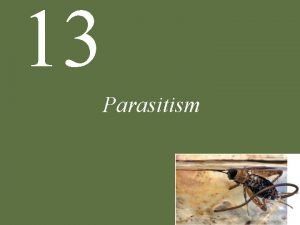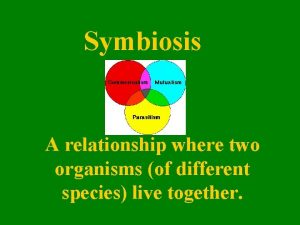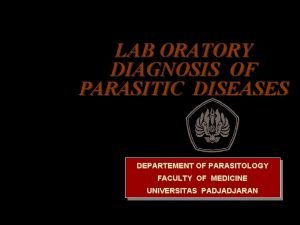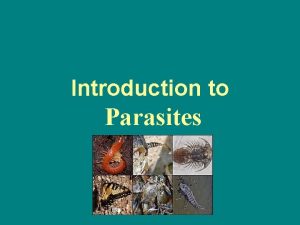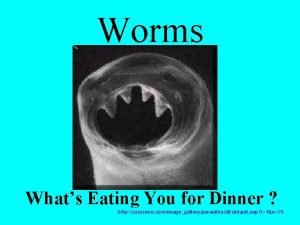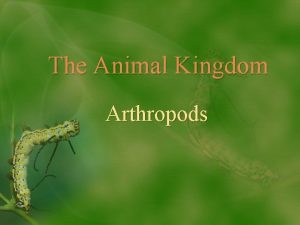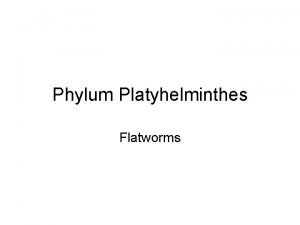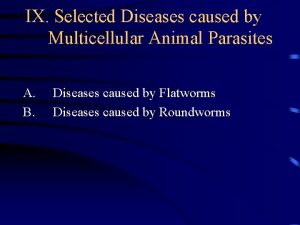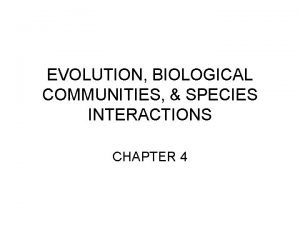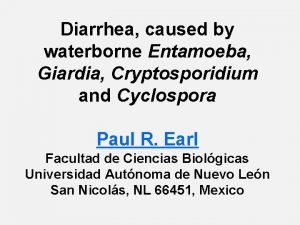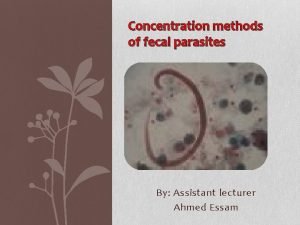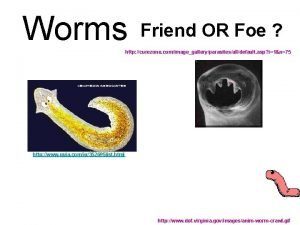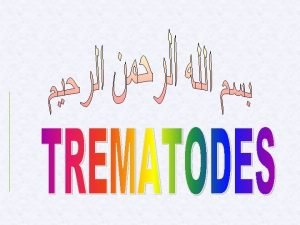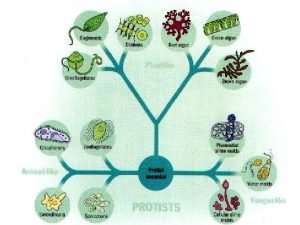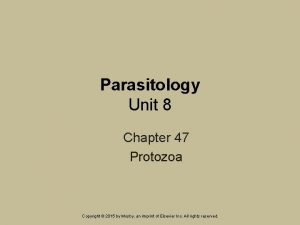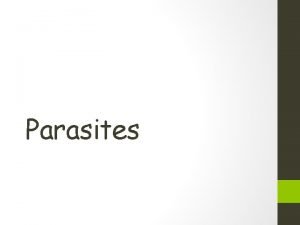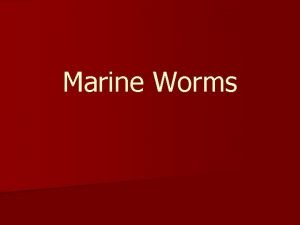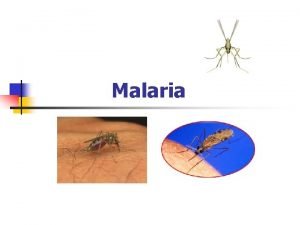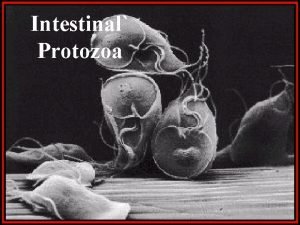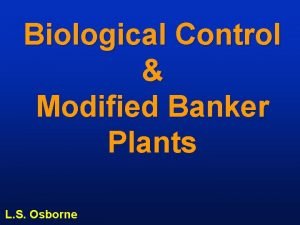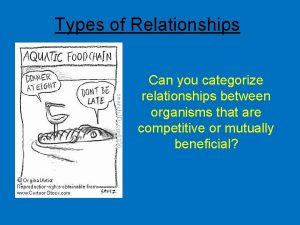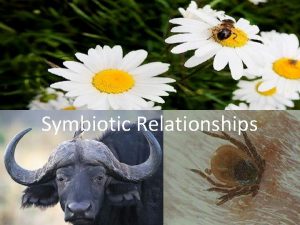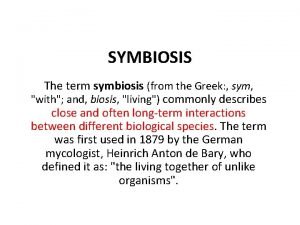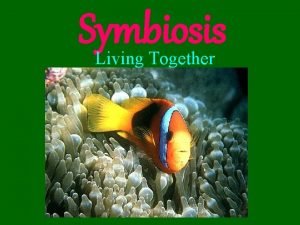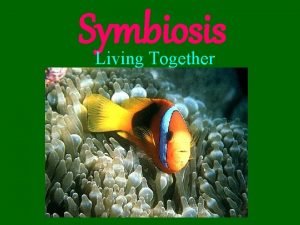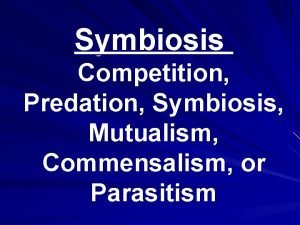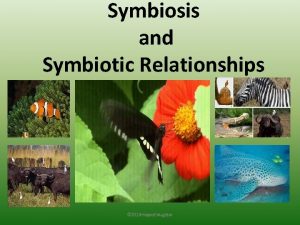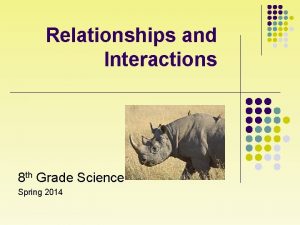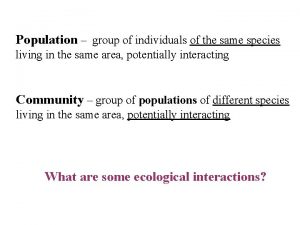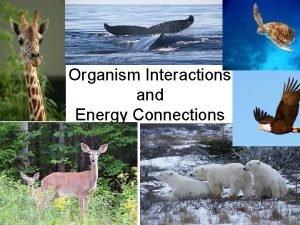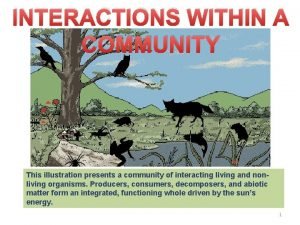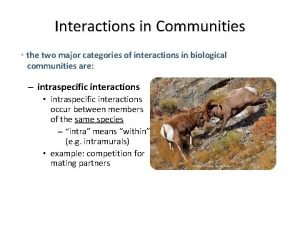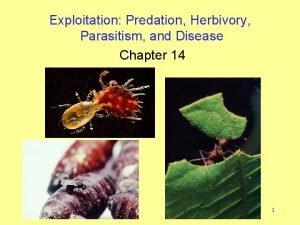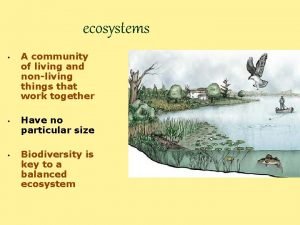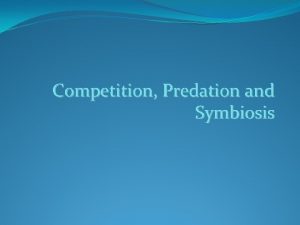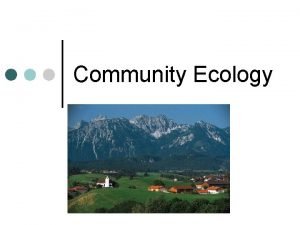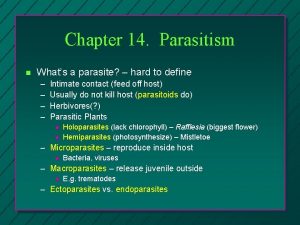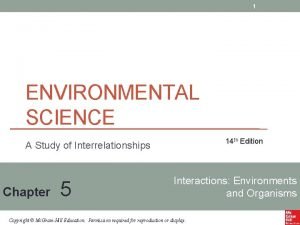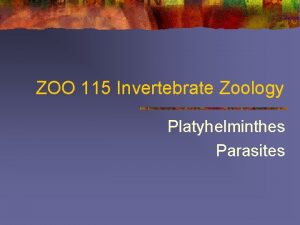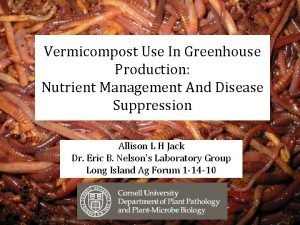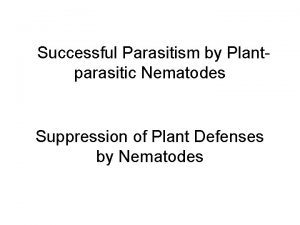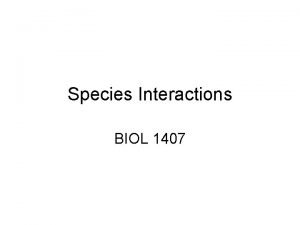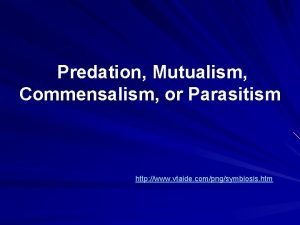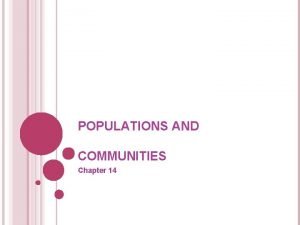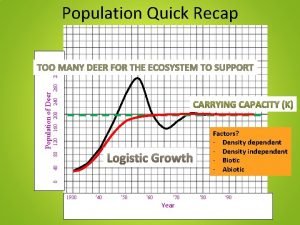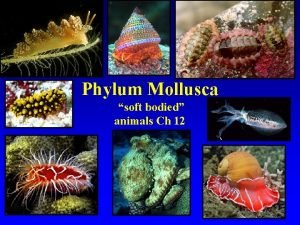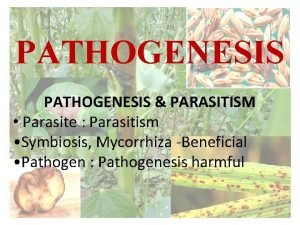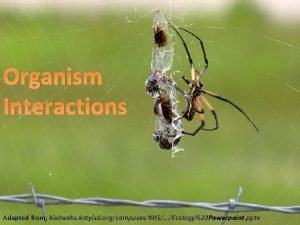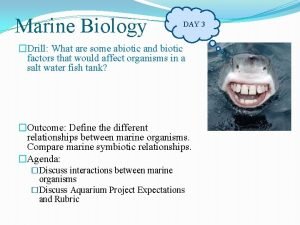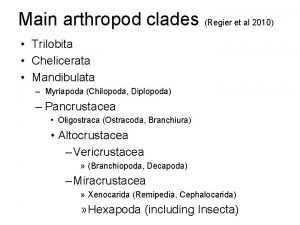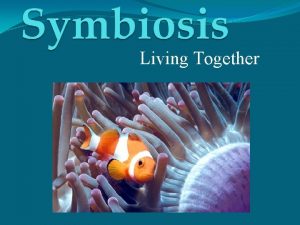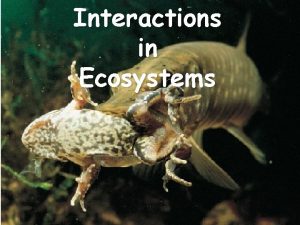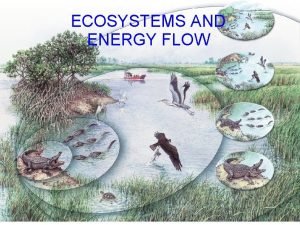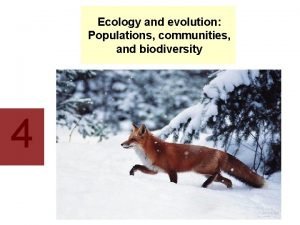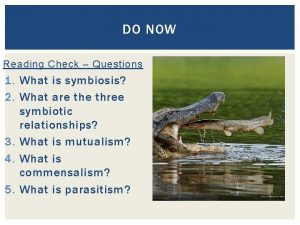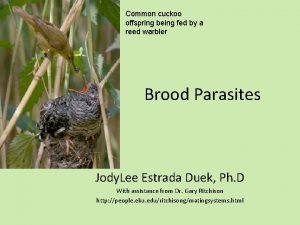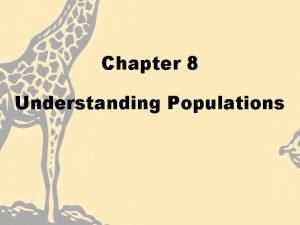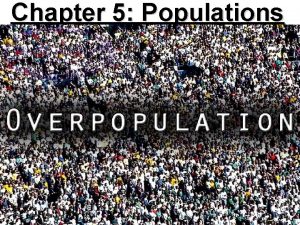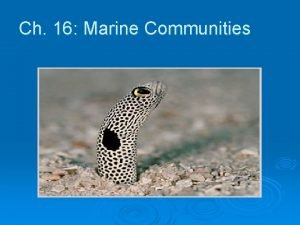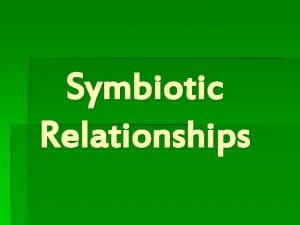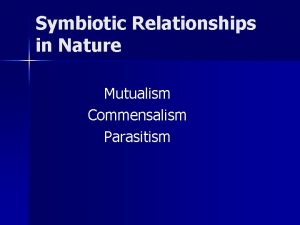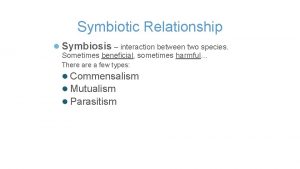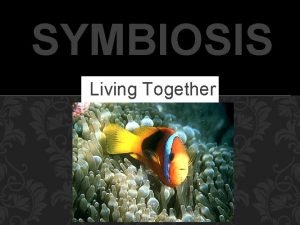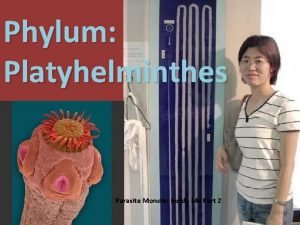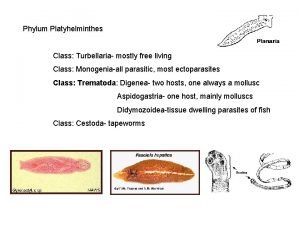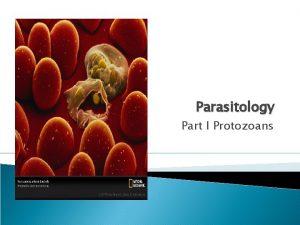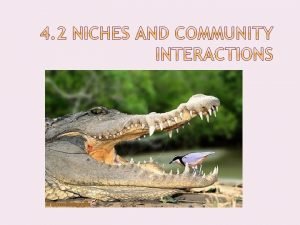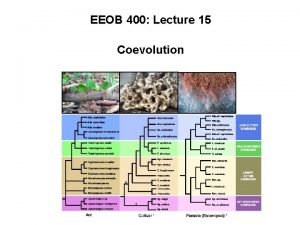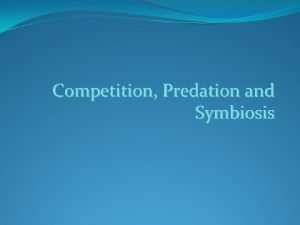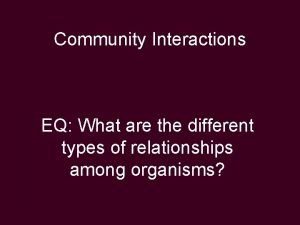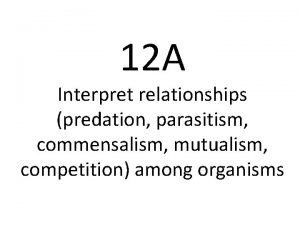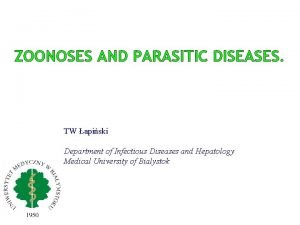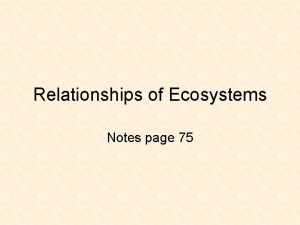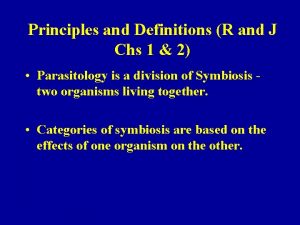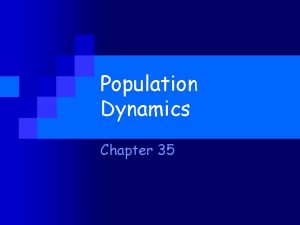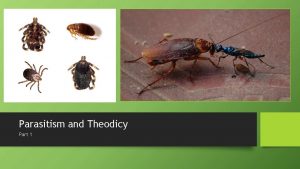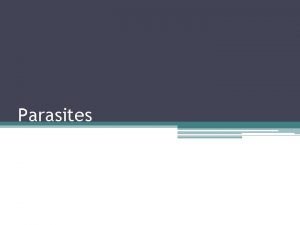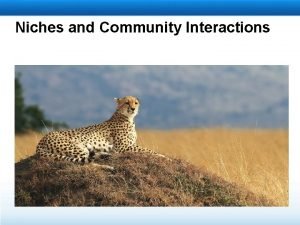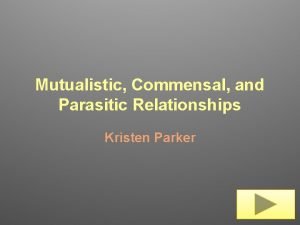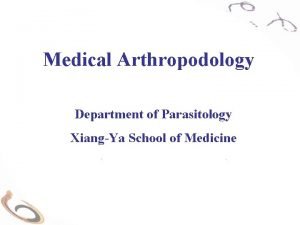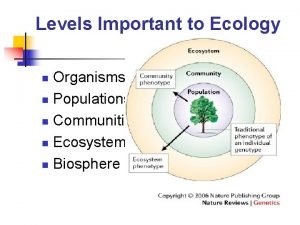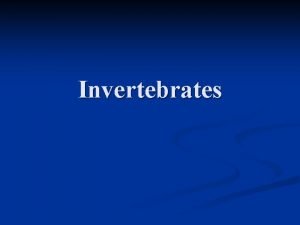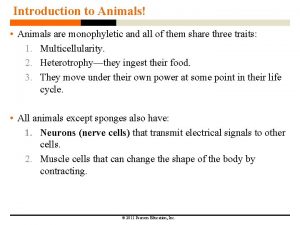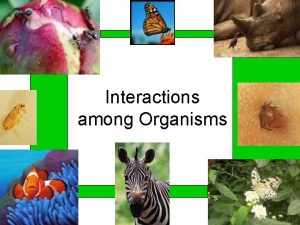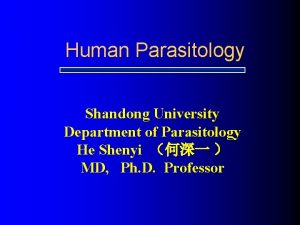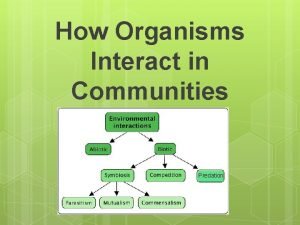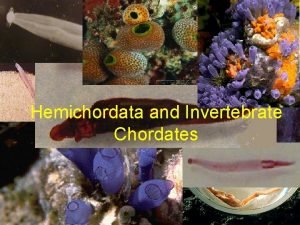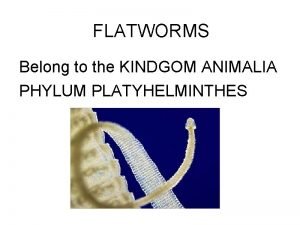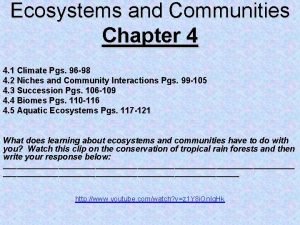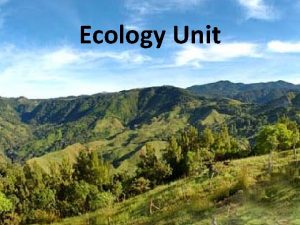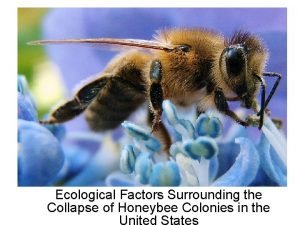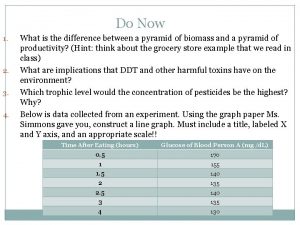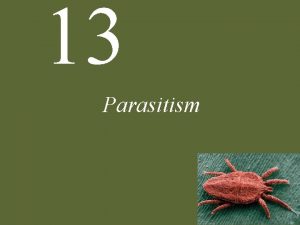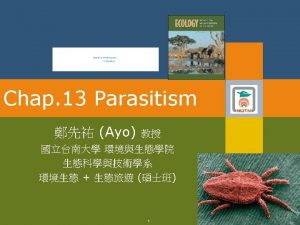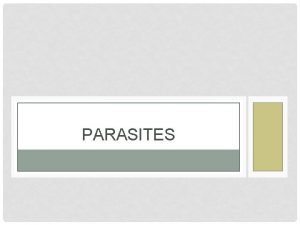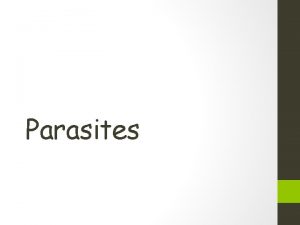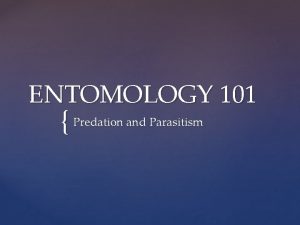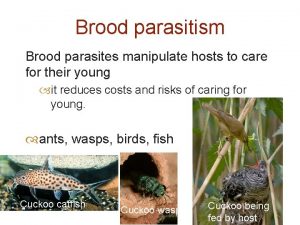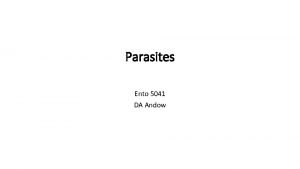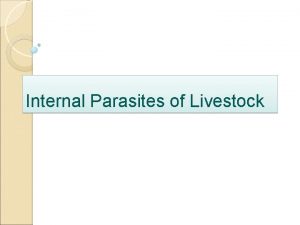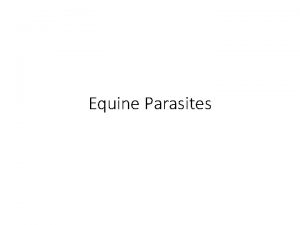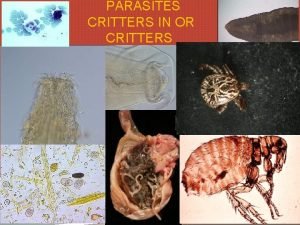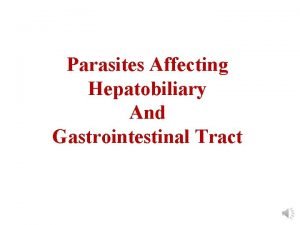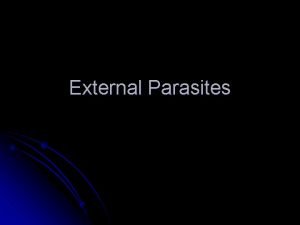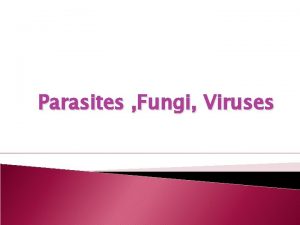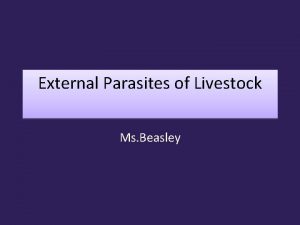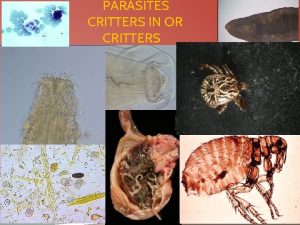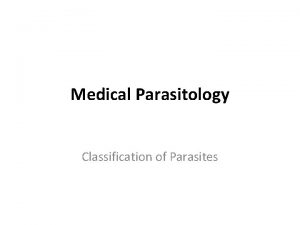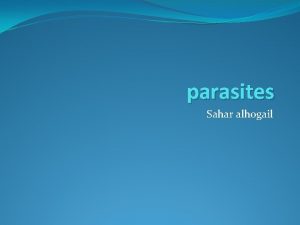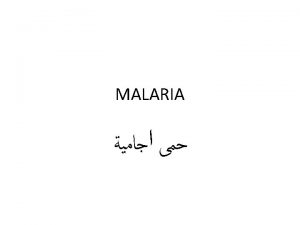13 Parasitism Chapter 13 Parasitism Enslaver Parasites A






















































































































- Slides: 118

13 Parasitism

Chapter 13 Parasitism Enslaver Parasites: A Case Study Introduction CONCEPT 13. 1 Parasites typically feed on only one or a few host individuals Parasite Natural History CONCEPT 13. 2 Hosts have adaptations for defending themselves against parasites, and parasites have adaptations for overcoming host defenses Defenses and Counterdefenses CONCEPT 13. 3 Host and parasite populations can evolve together, each in response to selection pressure imposed by the other Parasite–Host Coevolution

Chapter 13 Parasitism CONCEPT 13. 4 Parasites can reduce the sizes of host populations and alter the outcomes of species interactions, thereby causing communities to change Ecological Effects of Parasites CONCEPT 13. 5 Simple models of host–pathogen dynamics suggest ways to control the establishment and spread of diseases Dynamics and Spread of Diseases A Case Study Revisited: Enslaver Parasites Connections in Nature: From Chemicals to Evolution and Ecosystems

Enslaver Parasites: A Case Study Some parasites can alter the behavior of their host in order to complete their life cycles.

Enslaver Parasites: A Case Study Hairworm life cycle: A cricket drinks water that contains a hairworm larva. Larva enters the cricket’s body and feeds on its tissues, growing into an adult that fills the cricket’s body cavity. The cricket then jumps into water and drowns; the hairworm emerges and mates.

Enslaver Parasites: A Case Study Many parasites “enslave” their hosts. Some fungi alter the perching behavior of their fly hosts so that their spores can be dispersed more easily.

Figure 13. 2 Enslaved by a Fungus

Introduction Symbionts: organisms that live in or on other organisms More than half of Earth’s species are symbionts. Our own bodies can be a home to many other species.

Figure 13. 3 The Human Body as Habitat

Introduction A parasite consumes the tissues or body fluids of the organism on which it lives (the host). Pathogens are parasites that cause diseases.

Introduction Parasites typically harm, but don’t immediately kill, the organisms they eat (unlike predators). Degree of harm varies widely. Compare: The fungus that causes athlete’s foot, and Yersinia pestis, the bacterium that causes the plague.

Concept 13. 1 Parasite Natural History Concept 13. 1 Parasites typically feed on only one or a few host individuals. Include herbivores such as aphids or nematodes that feed on one or a few host plants Parasitoids: insects whose larvae feed on a single host and almost always kill it.

Concept 13. 1 Parasite Natural History Macroparasites: large species such as arthropods and worms Microparasites: microscopic, such as bacteria

Concept 13. 1 Parasite Natural History Most species are attacked by more than one kind of parasite; even parasites have parasites. Many parasites are closely adapted to particular host species. This specialization helps explain why there are so many species of parasites.

Figure 13. 4 Many Species Are Host to More Than One Parasite Species

Concept 13. 1 Parasite Natural History Ectoparasites live on the outer body surface of the host. Endoparasites live inside their hosts, within cells or tissues, or in the alimentary canal.

Concept 13. 1 Parasite Natural History Plant ectoparasites: Dodder gets water and food from the host plant via specialized roots called haustoria. Mistletoes are hemiparasitic—they get water and nutrients from the host but can also photosynthesize.

Figure 5. 3 Plant Parasites

Concept 13. 1 Parasite Natural History Many fungi are ectoparasites. More than 5, 000 species of fungi attack crop plants. Mildews, rusts, and smuts grow on the surface and extend their hyphae (fungal filaments) into the plant to extract nutrients from its tissues.

Figure 13. 5 Ectoparasites

Concept 13. 1 Parasite Natural History Plants are also attacked by animals ectoparasites: Aphids, whiteflies, scale insects, nematodes, beetles, and juvenile cicadas. They can be thought of as both herbivores and parasites.

Concept 13. 1 Parasite Natural History Animals also have many ectoparasites. Examples: Athlete’s foot fungus, fleas, mites, lice, and ticks Some of these parasites also transmit disease organisms.

Concept 13. 1 Parasite Natural History Many disease organisms are endoparasites. The alimentary canal is excellent habitat for many parasites. Most do not eat host tissue, but rob the host of nutrients. Tapeworms attach to the host’s intestinal wall and absorb digested food.

Concept 13. 1 Parasite Natural History Many endoparasites live in the host’s tissues or cells. Examples: Yersinia pestis, the bacterium that causes the plague Mycobacterium tuberculosis, the bacterium that causes tuberculosis

Figure 13. 6 Endoparasites

Concept 13. 1 Parasite Natural History Plants also have endoparasites. Bacterial pathogens cause soft rot; fungi can rot various plant parts from the inside out. Some bacteria invade vascular tissues, disrupting the flow of water and nutrients, causing wilting and often death.

Concept 13. 1 Parasite Natural History Ectoparasites can disperse more easily than endoparasites. Endoparasites have evolved various mechanisms for dispersal, including complex life cycles and enslaver parasites. Some parasites of the alimentary canal are dispersed in feces.

Concept 13. 1 Parasite Natural History Ectoparasites are more exposed to predators, parasites, and parasitoids. Example: Aphids are eaten by many birds and insects, and attacked by parasites and parasitoids.

Concept 13. 1 Parasite Natural History Endoparasites are protected from the external environment, and have easy access to food. But they can also be attacked by the host’s immune system.

Table 13. 1 Advantages and Disadvantages of Living in or on a Host

Concept 13. 2 Defenses and Counterdefenses Concept 13. 2: Hosts have adaptations for defending themselves against parasites, and parasites have adaptations for overcoming host defenses. Parasites exert strong selection pressure on their host organisms, and vice-versa.

Concept 13. 2 Defenses and Counterdefenses Host organisms have many kinds of defense mechanisms. Protective outer coverings include skin and exoskeletons. Many parasites that do gain entry are killed by the host’s immune system.

Concept 13. 2 Defenses and Counterdefenses Vertebrate immune systems have “memory cells” that can recognize microparasites from previous exposures. Other immune system cells engulf and destroy parasites or mark them with chemicals that target them for later destruction.

Concept 13. 2 Defenses and Counterdefenses Plants also have defense systems: • Resistance genes • Nonspecific immune responses such as antimicrobial and antifungal compounds • Chemical signals that “warn” nearby cells of imminent attack • Chemicals that stimulate deposition of lignin, which makes a barrier to stop an invader’s spread

Figure 13. 7 Nonspecific Plant Defenses

Concept 13. 2 Defenses and Counterdefenses Hosts can regulate biochemistry to deter parasites. Example: Vertebrate hosts have a protein called transferrin that removes iron from blood serum and stores it so bacterial and fungal endoparasites can’t get it. But some parasites can steal iron from the transferrin.

Concept 13. 2 Defenses and Counterdefenses Plants have many chemical weapons called secondary compounds. Some animals eat specific plants to treat or prevent parasite infections. Example: Woolly bear caterpillars switch from their usual food plants to poison hemlock when parasitic flies lay eggs on their bodies.

Concept 13. 2 Defenses and Counterdefenses Chimpanzees infected with nematodes seek out and eat a bitter plant that contains chemicals that kill or paralyze the nematodes (Huffman 1997).

Figure 13. 8 Using Plants to Fight Parasites

Concept 13. 2 Defenses and Counterdefenses In some species, females select mates based on traits that indicate that a male has good defenses. Female stickleback fish detect MHC (major histocompatibility complex) proteins by smell, and choose males with more MHC proteins, which provide protection from a range of parasites.

Concept 13. 2 Defenses and Counterdefenses Other species may use other cues to assess parasite loads. Males of a cichlid fish court females by constructing a sand bower. Females prefer males that make large, smooth bowers. These males have fewer tapeworms than those that make smaller bowers.

Concept 13. 2 Defenses and Counterdefenses Parasite counterdefenses: Ectoparasites must penetrate external defenses and toxic compounds produced by plants. Endoparasites must cope with defenses found inside the host.

Concept 13. 2 Defenses and Counterdefenses Some hosts can encapsulate endoparasites, or their eggs, to make them harmless. Some insects have lamellocytes—blood cells that can form multicellular capsules around large objects such as nematodes.

Concept 13. 2 Defenses and Counterdefenses The parasites are under strong selection pressure to develop counterdefenses: • Parasitoid wasps that attack fruit flies avoid encapsulation by injecting viruslike particles that infect the lamellocytes and cause them to self-destruct. • Others lay eggs covered with filaments that become embedded in the host’s fat cells where they are not detected by circulating lamellocytes.

Concept 13. 2 Defenses and Counterdefenses Some endoparasites have complex adaptations. Plasmodium, the protozoan that causes malaria, has a complex life cycle with two hosts: mosquitoes and humans.

Figure 13. 9 Life Cycle of the Malaria Parasite, Plasmodium

Concept 13. 2 Defenses and Counterdefenses Plasmodium faces two challenges in the human host: • Red blood cells do not divide or grow, and don’t import nutrients. • 24– 48 hours after infection, Plasmodium causes red blood cells to have an abnormal shape. These cells are destroyed in the spleen.

Concept 13. 2 Defenses and Counterdefenses Plasmodium has hundreds of genes whose function is to modify red blood cells. Some genes cause transport proteins to be placed on red blood cell surfaces to transport nutrients.

Concept 13. 2 Defenses and Counterdefenses Other genes direct production of knobs on the surface of red blood cells that stick to other cells, preventing them from reaching the spleen where they would be destroyed. Proteins on the knobs vary greatly from one individual parasite to the next, making it very difficult for the human immune system to detect them.

Concept 13. 3 Parasite–Host Coevolution Concept 13. 3: Host and parasite populations can evolve together, each in response to selection imposed by the other. When parasite and host each possess specific adaptations, it suggests that the strong selection pressure they impose on each other has caused both populations to evolve.

Concept 13. 3 Parasite–Host Coevolution This has been observed in Australia, where European rabbits were introduced in 1859. The rabbit population exploded, and various control methods failed. The Myxoma virus was introduced in 1950; 99. 8 percent of infected rabbits died.

Concept 13. 3 Parasite–Host Coevolution But over time, the rabbits evolved resistance to the virus, and the virus evolved to become less lethal. Myxoma is still used, but it requires a constant search for new strains of the virus.

Figure 13. 10 Coevolution of the European Rabbit and the Myxoma Virus (Part 1)

Figure 13. 10 Coevolution of the European Rabbit and the Myxoma Virus (Part 2)

Concept 13. 3 Parasite–Host Coevolution The rabbit and myxoma virus illustrate coevolution: when populations of two interacting species evolve together, each in response to selection imposed by the other

Concept 13. 3 Parasite–Host Coevolution Some plant genotypes have resistance genes to specific parasite genotypes: gene-for-gene interactions. Wheat has dozens of different genes for resistance to fungi such as wheat rusts. Different wheat rust genotypes can overcome different wheat resistance genes.

Concept 13. 3 Parasite–Host Coevolution Periodically, mutations occur in wheat rusts that produce new genotypes to which wheat is not resistant. Frequencies of wheat rust genotypes vary considerably over time, as farmers plant different varieties of wheat.

Concept 13. 3 Parasite–Host Coevolution Change in frequencies of host and parasite genotypes were shown in a trematode worm and its snail host in New Zealand lakes. Lively (1989) found that parasites infected snails from their home lake more effectively than they infected snails from other lakes.

Figure 13. 11 Adaptation by Parasites to Local Host Populations

Concept 13. 3 Parasite–Host Coevolution Parasite genotypes in each lake had evolved rapidly enough to overcome the defenses of the snail genotypes found in that lake. The snails also evolved in response to the parasites. Over the period of 5 years, the most abundant genotype changed from year to year.

Concept 13. 3 Parasite–Host Coevolution Lab experiments showed that parasites infect snails with a common genotype more often than snails with a rare genotype. Because common genotypes are attacked by many parasites, driving down their numbers in future years, the genotype frequencies vary year to year.

Figure 13. 12 Parasites Infect Common Host Genotypes More Easily Than Rare Genotypes

Concept 13. 3 Parasite–Host Coevolution Ever-escalating “arms races” rarely occur. As with the snails and trematodes, common host genotypes decrease in frequency because they are attacked by many; leading to an increase in previously rare genotypes.

Concept 13. 3 Parasite–Host Coevolution An arms race may stop because of tradeoffs: a trait that improves host defenses or parasite counterdefenses may reduce some other aspect of growth, survival, or reproduction.

Concept 13. 3 Parasite–Host Coevolution In fruit flies and their parasitoids, there are costs for encapsulation and for avoiding encapsulation. Ability to encapsulate is associated with lower larval survival rates. Wasp eggs that avoid encapsulation by embedding in host tissue take longer to hatch than other eggs.

Concept 13. 3 Parasite–Host Coevolution In studies of wild flax and a rust pathogen: Some rust genotypes are more virulent (can overcome more plant resistance genes). Virulent rust genotypes were common only in host populations dominated by plants with many resistance genes.

Concept 13. 3 Parasite–Host Coevolution The trade-off: virulent rust genotypes produce fewer spores than other genotypes. In flax populations with few resistance genes, there is no advantage to being virulent.

Figure 13. 13 A Cost of Virulence

Concept 13. 4 Ecological Effects of Parasites Concept 13. 4: Parasites can reduce the sizes of host populations and alter the outcomes of species interactions, thereby causing communities to change. Parasites can reduce survival or reproduction of their host. Experiments with a beetle and a sexually transmitted mite showed a decrease in egg production by infected females.

Figure 13. 14 Parasites Can Reduce Host Reproduction (Part 1)

Figure 13. 14 Parasites Can Reduce Host Reproduction (Part 2)

Concept 13. 4 Ecological Effects of Parasites At the population level, harm done by parasites translates into reduction of population growth rates. Parasites can drive local host populations extinct and reduce their geographic ranges.

Concept 13. 4 Ecological Effects of Parasites An amphipod (Corophium) in North Atlantic tidal mudflats can be extremely abundant —up to 100, 000/m 2. A trematode parasite can reduce amphipod populations dramatically. In a 4 -month period, attack by trematodes caused extinction of a Corophium population.

Concept 13. 4 Ecological Effects of Parasites The American chestnut (Castanea dentata) was a dominant tree in eastern North America. A fungal pathogen that causes chestnut blight was introduced from Asia in 1904. By mid-century, the fungus had wiped out most chestnut populations and greatly reduced the geographic range of this species.

Figure 13. 15 Parasites Can Reduce Their Host’s Geographic Range

Concept 13. 4 Ecological Effects of Parasites can impact host population cycles: Hudson et al. (1998) manipulated numbers of parasites in red grouse populations, which tend to crash every 4 years. A parasitic trematode was known to decrease survival and reproductive success.

Concept 13. 4 Ecological Effects of Parasites When grouse populations were expected to crash, two populations were treated with a drug to kill the parasite. In control populations, numbers crashed as predicted. Parasite removal in the other populations reduced fluctuations.

Figure 13. 16 Parasite Removal Reduces Host Population Fluctuations

Concept 13. 4 Ecological Effects of Parasites By reducing host performance and growth rates, parasites can change the outcome of species interactions, community composition, and even the physical environment.

Concept 13. 4 Ecological Effects of Parasites Species interactions: Park (1948) did experiments with two flour beetles (Tribolium castaneum and T. confusum) and a protozoan parasite. When the parasite was absent, T. castaneum outcompeted T. confusum, driving it to extinction in most cases.

Concept 13. 4 Ecological Effects of Parasites When the parasite was present, the opposite occurred. The outcome was reversed because the parasite had a large negative effect on T. castaneum, but virtually no effect on T. confusum.

Figure 13. 17 Parasites Can Alter the Outcome of Competition

Concept 13. 4 Ecological Effects of Parasites can alter the outcome of predator–prey interactions by decreasing the physical condition of infected individuals. Predators may be less able to catch their prey, or prey less able to escape predation.

Concept 13. 4 Ecological Effects of Parasites can also change the behavior of their host, such as the protozoan that makes rats less wary of cats. Some worm parasites cause amphipods to move from sheltered areas to areas of bright light, where they are more likely to be seen and eaten by fish or bird predators.

Concept 13. 4 Ecological Effects of Parasites Community Structure: A parasite that attacks a dominant competitor can suppress that species, causing other species to increase. In stream communities (Kohler and Wiley, 1997), a caddisfly Glossosoma nigrior was the dominant herbivore before outbreaks of a fungal pathogen.

Concept 13. 4 Ecological Effects of Parasites The fungus reduced Glossosoma population densities by 25 -fold. This allowed many other species— including algae, other grazing insects, and filter feeders—to increase. Many of these species were previously rare.

Concept 13. 4 Ecological Effects of Parasites Physical Environment: Ecosystem engineer species can change the physical character of the environment, as when a beaver builds a dam. The amphipod Corophium is an ecosystem engineer in tidal mudflats.

Concept 13. 4 Ecological Effects of Parasites The burrows built by Corophium hold the mud together, preventing erosion and forming “mud islands” at low tide.

Concept 13. 4 Ecological Effects of Parasites When the parasite drives Corophium populations to extinction, erosion increases and the islands disappear.

Figure 13. 18 Parasites Can Alter the Physical Environment

Concept 13. 5 Dynamics and Spread of Diseases Concept 13. 5: Simple models of host– pathogen dynamics suggest ways to control the establishment and spread of diseases. Pathogens have had a major effect on human populations. They are thought to have played a major role in the rise and fall of civilizations throughout history.

Concept 13. 5 Dynamics and Spread of Diseases Mathematical models of host–pathogen population dynamics: • Host population is divided into susceptible individuals (S), infected individuals (I), and recovered and immune individuals (R). • It is often necessary to keep track of both host and pathogen genotypes.

Concept 13. 5 Dynamics and Spread of Diseases • Other factors may be involved: 1. Host age may affect likelihood of infection. 2. A latent period in which an individual is infected but can’t spread the disease. 3. Vertical transmission—disease is passed from mother to newborn.

Concept 13. 5 Dynamics and Spread of Diseases A simple model shows that a disease will spread only if the density of susceptible hosts exceeds a critical, threshold density.

Concept 13. 5 Dynamics and Spread of Diseases Density of susceptible individuals = S, density of infected individuals = I. Probability of infected individuals encountering susceptible individuals = SI. β = transmission coefficient (how effectively the disease spreads)

Concept 13. 5 Dynamics and Spread of Diseases Density of infected individuals increases when the disease is transmitted successfully and decreases when infected individuals die or recover. Death and recovery rate = d.

Concept 13. 5 Dynamics and Spread of Diseases A disease will spread when d. I/dt > 0 This occurs when βSI – d. I > 0 or S > d/β. A disease will establish and spread when the number of susceptible individuals exceeds threshold density, ST = d/β.

Concept 13. 5 Dynamics and Spread of Diseases There are several ways to keep the number of susceptible individuals below the threshold. Susceptible domestic animals are sometimes slaughtered to reduce density, especially if the disease can spread to humans, such as bird flu.

Concept 13. 5 Dynamics and Spread of Diseases For human populations, mass vaccination programs can reduce density of susceptible individuals. These programs have been successful for several diseases, including measles.

Figure 13. 19 Vaccination Reduces the Incidence of Disease

Concept 13. 5 Dynamics and Spread of Diseases Public health measures can raise ST: • Increase recovery rate of infected individuals who then have immunity, by early detection and improved treatment. • Decrease β by quarantining infected individuals or change behaviors to reduce disease transmission.

Concept 13. 5 Dynamics and Spread of Diseases In wild populations: Threshold densities were determined for bison populations susceptible to the bacterial disease brucellosis. Using National Park data, Dobson and Meagher (1996) found ST to be 200– 300 per herd (similar to model-calculated ST of 240).

Figure 13. 20 Determining Threshold Population Densities

Concept 13. 5 Dynamics and Spread of Diseases Herd sizes in the parks were 1000 to 3000 individuals. Neither option for reducing ST was feasible: A vaccine was not available; killing large numbers of bison was not acceptable, politically or ecologically (small herds have higher risk of extinction).

Concept 13. 5 Dynamics and Spread of Diseases Climate change is affecting distribution of diseases. Increasing water temperatures are correlated with increased disease in coral reefs, shellfish, and amphibians. Mosquitoes and other disease vectors are more active and reproduce more in warm conditions.

Concept 13. 5 Dynamics and Spread of Diseases Geographic ranges of vectors and reservoir species may shift. Risk of leishmaniasis, malaria, cholera, and the plague may increase.

Figure 13. 21 Climate Change May Increase the Risk of Leishmaniasis in North America

Concept 13. 5 Dynamics and Spread of Diseases How climate change affects any given disease will be complicated by many factors: • Range shifts may put more or fewer people at risk • Control efforts • Ecological interactions involving pathogens and hosts

A Case Study Revisited: Enslaver Parasites How do enslaver parasites manipulate the behavior of their hosts?

A Case Study Revisited: Enslaver Parasites Larvae of a tropical parasitoid wasp attach to a host spider’s abdomen and suck the body fluids. When grown, the larva induces the spider to build a cocoon web, then kills the spider and eats it. The larva then spins a cocoon and attaches it to the cocoon web.

Figure 13. 22 Parasites Can Alter Host Behavior

A Case Study Revisited: Enslaver Parasites In experiments, wasp larvae were removed from host spiders just before a cocoon web would be made. The spiders then made webs different from both normal webs and cocoon webs. Some spiders recovered normal webmaking ability after several days.

A Case Study Revisited: Enslaver Parasites This suggests that the larva injects a fastacting chemical into the spider to alter behavior. The chemical appears to interrupt the spiders’ usual sequence of web-building behaviors. The specific chemical has not been found.

A Case Study Revisited: Enslaver Parasites Other enslaver parasites manipulate the host’s biochemistry. Hairworms alter concentrations of amino acids in the brains of the cricket hosts. Taurine is a neurotransmitter in insects, and regulates the sense of thirst. The hairworm may induce the cricket to commit suicide by altering its perception of thirst.

A Case Study Revisited: Enslaver Parasites Hechtel et al. (1993) found that when parasitized by a worm, isopods were vulnerable to predation by creek chubs, the next host in the parasite’s life cycle. Unparasitized isopods avoided chubs, but parasitized isopods were drawn to the chubs; a benefit for the parasite but disaster for the isopod. A mechanism for the behavior change has not been found.

Figure 13. 23 Making the Host Vulnerable to Predation

Connections in Nature: From Chemicals to Evolution and Ecosystems Interactions between enslaver parasites and their hosts provide evidence of previous evolutionary change. Enslaver parasites have many adaptations to cope with host defenses. A parasite that uses a chemical is well adapted to take advantage of the body chemistry of its host.

Connections in Nature: From Chemicals to Evolution and Ecosystems Ecological interactions affect evolution, and vice-versa. As evolutionary change tips the balance back and forth, first in favor of the host, then in favor of the parasite, we can expect concomitant changes in the dynamics of other species.
 Enslaver parasites
Enslaver parasites Enslaver parasites
Enslaver parasites Two examples of parasite
Two examples of parasite Kato-katz and kato thick procedure
Kato-katz and kato thick procedure Parasites classification
Parasites classification Bacteria virus fungi and parasites
Bacteria virus fungi and parasites Curezone parasite
Curezone parasite Arthropod
Arthropod Flatworms acoelomates
Flatworms acoelomates Parasites alimentaires
Parasites alimentaires Multicellular animal parasites
Multicellular animal parasites Parasites of medical importance
Parasites of medical importance What do parasites eat
What do parasites eat How many herbivores are there
How many herbivores are there Chromatin
Chromatin Faciola
Faciola Curezone parasites
Curezone parasites Schistosomiasis granuloma
Schistosomiasis granuloma Is protozoa polyphyletic
Is protozoa polyphyletic Sarcomastigophora are unicellular immotile parasites
Sarcomastigophora are unicellular immotile parasites Parasites of livestock - vocabulary
Parasites of livestock - vocabulary Marine flatworm symmetry
Marine flatworm symmetry Malaria parasites under microscope
Malaria parasites under microscope Infective stage
Infective stage Luminal protozoa
Luminal protozoa Bankers are parasites
Bankers are parasites Categorize each relationship as mutualism or parasitism.
Categorize each relationship as mutualism or parasitism. Examples of commensalism
Examples of commensalism Parasitism
Parasitism Greek sym
Greek sym Mutualism
Mutualism Parasitism
Parasitism Commensalism emoji
Commensalism emoji Tomato hornworm and braconid wasp symbiotic relationship
Tomato hornworm and braconid wasp symbiotic relationship Parasitism
Parasitism Parasitism
Parasitism A group of individuals of the same species
A group of individuals of the same species Parasitism co to
Parasitism co to A food chain with 4 organisms
A food chain with 4 organisms Knowledge is the antidote to fear
Knowledge is the antidote to fear Biological succession
Biological succession Parasitism examples
Parasitism examples Interspecific competition relationship
Interspecific competition relationship Parasitism
Parasitism Compare and contrast mutualism and parasitism
Compare and contrast mutualism and parasitism Ecosystem living and nonliving things
Ecosystem living and nonliving things Parasitism
Parasitism Primary succession causes
Primary succession causes Whats parasitism
Whats parasitism Parasitism
Parasitism Parasitism
Parasitism Youtube youtube
Youtube youtube Parasitism
Parasitism Parasitism
Parasitism Parasitism
Parasitism Example of commensalism
Example of commensalism Vtaide
Vtaide Parasitism
Parasitism 120factors
120factors Parasitism
Parasitism Obligatory parasite
Obligatory parasite Parasitism examples
Parasitism examples Parasitism
Parasitism Tracheal gills
Tracheal gills Mutualism vs symbiosis
Mutualism vs symbiosis Parasitism
Parasitism 5 levels of organisms
5 levels of organisms Mutualism definition biology
Mutualism definition biology Parasitism
Parasitism Parasitism
Parasitism Parasitism relationship
Parasitism relationship Parasitism
Parasitism Auxin hormone
Auxin hormone Cuckoo being fed
Cuckoo being fed Define parasitism
Define parasitism Parasitism
Parasitism Section 5-1 how populations grow
Section 5-1 how populations grow Parasitism
Parasitism Parasitism
Parasitism Neutralism relationship examples
Neutralism relationship examples Mutualistic symbiosis examples
Mutualistic symbiosis examples Parasitism
Parasitism Symbiosis powerpoint
Symbiosis powerpoint Parasitism
Parasitism Parasite class
Parasite class Parasitism
Parasitism The place where an organism lives is called
The place where an organism lives is called Definition of parasitology
Definition of parasitology Parasitism
Parasitism Fig wasp
Fig wasp Parasitism
Parasitism Different types of community interactions
Different types of community interactions Multualism
Multualism Apiski
Apiski Caribou moss adaptations
Caribou moss adaptations Parasitism
Parasitism Broomrape and bursage relationship
Broomrape and bursage relationship Parasitism
Parasitism Energy paths
Energy paths Parasitism
Parasitism What is a parasitism
What is a parasitism Gage definition
Gage definition Commensalism parasite
Commensalism parasite Parasitism
Parasitism Parasitism pictures
Parasitism pictures Ecological relationships worksheet
Ecological relationships worksheet Invertebrates sponges characteristics
Invertebrates sponges characteristics Parasitism
Parasitism Difference between predation and parasitism
Difference between predation and parasitism Lamprey and fish relationship
Lamprey and fish relationship Taenia solium
Taenia solium Coevolution examples
Coevolution examples Hemichordata
Hemichordata Animalia
Animalia Parasitism
Parasitism Parasitism examples
Parasitism examples Parasitism examples
Parasitism examples Parasitism
Parasitism Parasitism
Parasitism
